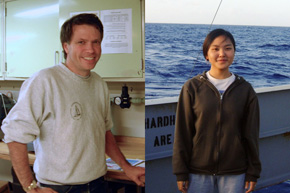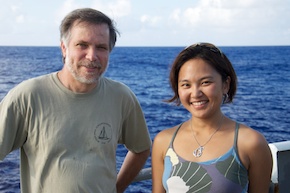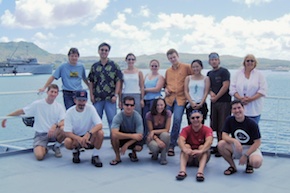The R/V Thomas G. Thompson left Honolulu on November 5, 2011 heading toward the Western Pacific. This expedition journal was written by cruise participants and uploaded about once per weekday, depending on internet availability.
December 2, 2011: Why are we doing this again?
Setting out to establish a historical timeline of Earth’s magnetic field seems like a mountainous task, but the equipment and geomagnetic scientists on our ship are able to do this even with miles of ocean between us and the area of interest. This is possible because the seafloor offers a predominantly unaltered record of the Earth’s magnetic field for the last ~180 million years. For the past twenty years, Dr. Maurice Tivey has been working to decipher the magnetic record of the Jurassic Quiet Zone, contained within the oldest and most isolated seafloor in the world, with the ultimate goal of fine-tuning this section of the geologic time scale.
The term “quiet” is a bit confusing at first glance, because it actually refers to something that makes no sound at all: a weak magnetic signature. We learned that the behavior of the Earth’s magnetic field during the Jurassic period is not widely agreed upon. The first ship-based magnetic surveys used only surface-tow magnetometers. But attempting to measure the magnetization of the seafloor through 6000 meters of water led to highly attenuated data, and volcanic activity in the region during the Cretaceous (sills, flows and seamounts) covered some of the Jurassic oceanic crust. The general conclusion was that the magnetic record in this ancient seafloor was too weak and geologically altered to interpret.
In 1992, H. Paul Johnson, William Sager, and Maurice Tivey led a research cruise using a magnetometer towed very close to the seafloor so that they could measure the signal closer to its source. Their survey area was limited in size because they had to conduct operations at slow speeds to keep the towed magnetometers at depth. (Maintaining the depth of the magnetometer is essential because the strength of the signal exponentially decreases as the distance from the source to the instrument increases.) Their data allowed them to deduce that the Jurassic Quiet Zone is not just quiet because of the age of the rocks, but because the Earth’s magnetic field was weaker during the Jurassic period. It also seemed to mark a change in the Earth’s magnetic field behavior, from one dominated by fluctuations in field strength to one dominated by frequent reversals in polarity.

Maurice and Masako in 2002
(Credit: Masako Tominaga)
In 2002, Maurice Tivey returned to the western side of the Jurassic Quiet Zone on this same ship, the R/V Thomas G. Thompson. Also on board was Masako Tominaga, a graduate student from Texas A&M. They came to revisit the 1992 survey line and extend it to the southeast, covering even older seafloor. They also used a series of low-resolution towed magnetometers that operated at deep and shallow depths. The results from the 2002 cruise strengthened the interpretations from the 1992 cruise, that the Earth’s magnetic field was weak and rapidly flipping its polarity during the Jurassic Quiet Zone. However, both surveys were conducted on seafloor created at a single spreading center. In order to determine if the field behavior was global, Masako and Maurice wanted to study rocks created at another geographic location. They also determined it was necessary to add in a seismic survey to compliment the magnetic data collection and identify regions of Cretaceous volcanic overprinting.

Maurice and Masako in 2011
(Credit: Will Koeppen)
That brings us to where we are today, 24 days into the third Jurassic Quiet Zone magnetic survey. We are surveying magnetic lineations on the eastern side of the Jurassic seafloor. If our data from the Hawaiian Lineation Set matches those of the Japanese Lineation Set (measured in 1992 and 2002), it will show that the same magnetic field was present at two different spreading centers providing evidence for a globally consistent magnetic field. In 1992 and 2002, the technology for obtaining high-resolution magnetic data collection was unavailable, making interpretation of the anomalies challenging. Nine years later, we are using improved technology. To correlate with the data collected on previous cruises, we are towing shallow and mid-depth magnetometers (Maggie and TowCam). In addition we have mounted three higher resolution magnetometers on the deep-diving AUV-Sentry. Sentry has a sophisticated navigation system allowing it to maintain its position 100 meters above the seafloor without being attached to the ship. Our seismic surveys will help us differentiate any Cretaceous volcanic overlay from the Jurassic crust.
In combining the new data with the old data, we can get a much more definitive picture about Earth’s magnetic field during the Jurassic, revealing another piece of our planet’s history. ♦

